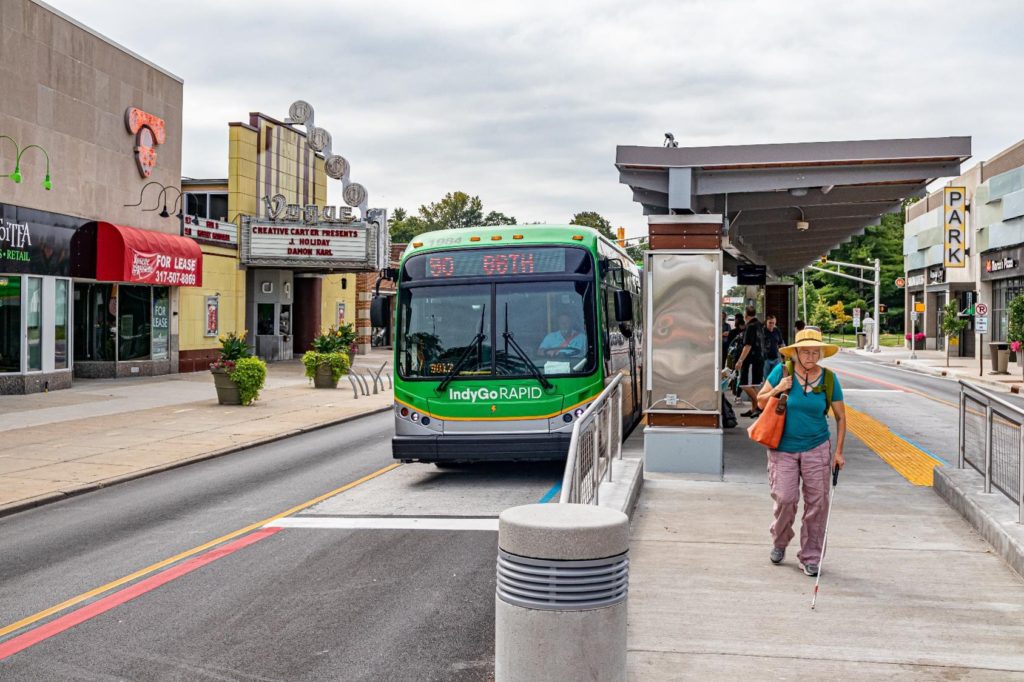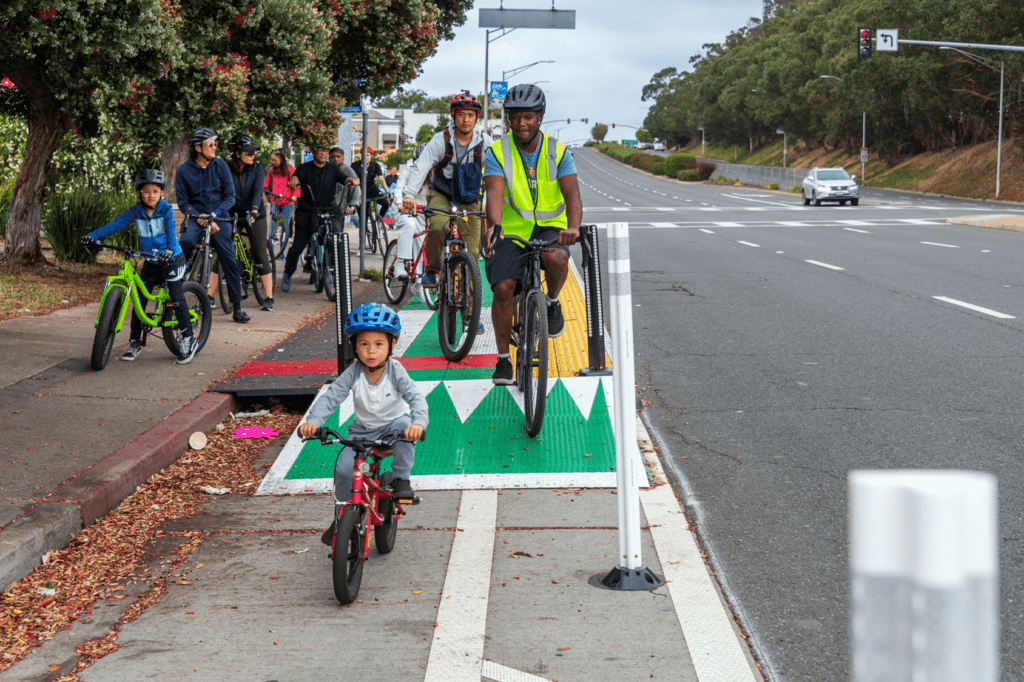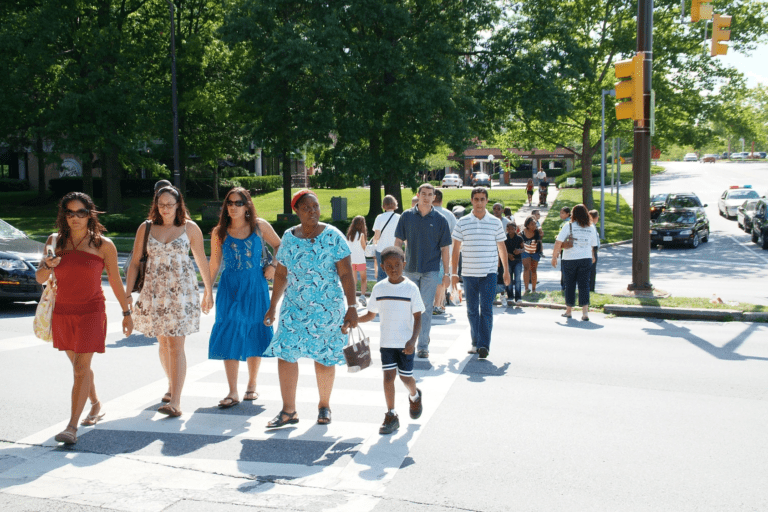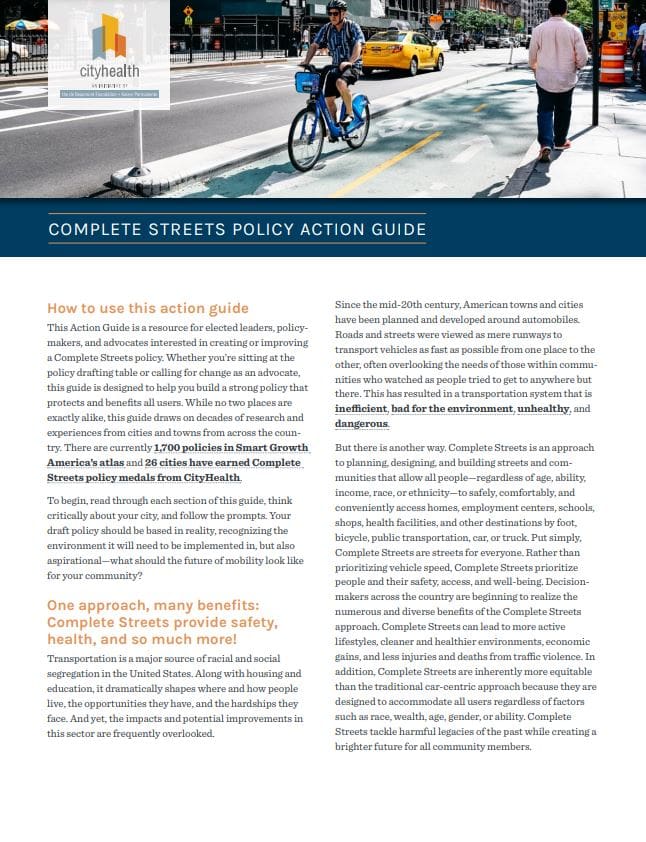This Action Guide is a resource for elected leaders, policymakers, and advocates interested in creating or improving a Complete Streets policy. Whether you’re sitting at the policy drafting table or calling for change as an advocate, this guide is designed to help you build a strong policy that protects and benefits all users.
Complete Streets is an approach to planning, designing and building streets and communities that allow all people — regardless of age, ability, income, race or ethnicity — to safely, comfortably, and conveniently access homes, entertainment centers, schools. shops, health facilities, and other destinations by foot, bicycle, public transportation, car, or truck.
Excerpts of the policy guide are below, and download the full guide here.
Produced in partnership with Smart Growth America.
How to use this action guide
 While no two places are exactly alike, this guide draws on decades of research and experiences from cities and towns from across the country. There are currently 1,700 policies in Smart Growth America’s atlas and 26 cities have earned Complete Streets policy medals from CityHealth.
While no two places are exactly alike, this guide draws on decades of research and experiences from cities and towns from across the country. There are currently 1,700 policies in Smart Growth America’s atlas and 26 cities have earned Complete Streets policy medals from CityHealth.
To begin, read through each section of this guide, think critically about your city, and follow the prompts. Your draft policy should be based in reality, recognizing the environment it will need to be implemented in, but also aspirational — what should the future of mobility look like for your community?
Policy type options—not all are created equal
 Complete Streets policies come in a variety of forms. For maximum impact and long-term viability, it is best to craft a strong and binding policy. While there are multiple options for policy types, some are stronger than others. For example, a legally binding law/ordinance generally has more impact and is harder to undo than a resolution or even an executive order that can be undone by a future executive. Your ability to create a binding policy may be constrained by certain factors, but you should be as bold and ambitious as possible in choosing the type of policy.
Complete Streets policies come in a variety of forms. For maximum impact and long-term viability, it is best to craft a strong and binding policy. While there are multiple options for policy types, some are stronger than others. For example, a legally binding law/ordinance generally has more impact and is harder to undo than a resolution or even an executive order that can be undone by a future executive. Your ability to create a binding policy may be constrained by certain factors, but you should be as bold and ambitious as possible in choosing the type of policy.
Inventory of Complete Streets policies in the United States according to SGA’s Policy Atlas (as of June 2023) and strong examples of each type:
Non-binding, official statements of support from a jurisdiction’s legislative branch for approaching community transportation projects as a way to improve access, safety, public health, quality of life, equity, etc.
Total Count: 741
Statements adopted by an elected body (e.g., city council). May be developed by an internal group of stakeholders, such as representatives from departments of planning, engineering, public works, health, and/or elected officials, or a broader group that includes residents and community stakeholders. Policies tend to be lengthier and more detailed than resolutions or ordinances.
Total Count: 503
Lexington-Fayette Urban County Government Complete Streets Policy
A binding law that mandates Complete Streets approaches. Processes may vary, but city departments and commissions often approve ordinance language before it moves to the legislative branch.
Total Count: 284
Documents that project near and medium-term plans and goals for transportation and land use. Common examples include comprehensive plans or transportation plans.
Total Count: 101
Internal policy
Created and issued “in house” by a government department. Though not mandated by law, such policies generally have good support from transportation professionals and are likely to be accompanied by changes in practice to ensure implementation.
Total County: 49
City of Portland Bureau of Transportation Complete Street Policy: Director’s Statement
Documents that help engineers determine appropriate characteristics of roadways. Used in all phases of transportation projects.
Total Count: 16
Executive order
High-level directives issued by the city’s chief executive (often the mayor). Executive orders help define problems and direct department heads to make necessary changes.
Total Count: 16
A legislative or voter-approved ordinance to fund Complete Streets projects.
Total Count: 3

Drafting A Strong Complete Streets Policy
11 Easy Steps to Creating a Great Policy
The vision and commitment statement will succinctly make the case for why Complete Streets are important overall and to your community. Anyone who reads the policy should easily understand why it exists and how it intends to change the world you live in. There should also be no ambiguity about the need to prioritize active modes of transportation. This section is often found in the beginning of a Complete Streets policy, however the vision and intent should be reflected throughout the document.
For Complete Streets to be truly effective, it is important to build a comprehensive network. Piecemeal projects are not enough. A short and isolated sidewalk or bike path does little to improve mobility for users. Complete Streets must touch every part of the network and allow people to get around in a safe, efficient, and dignified manner. Thus, the scope of a Complete Streets policy should be as broad as possible. It should clearly specify that all projects, programs, and interventions are to follow the policy. Furthermore, Complete Streets should be the default approach for all phases, not something extra to add at the end of a project. This means Complete Streets are central to planning, design, construction, operation, and maintenance. If the jurisdiction of the policy is left open, or unstated, it can open the door for uncertainty, corner cutting, and significant omissions.
The policy should use unambiguous language and spell out the applicability to all projects, programs, and interventions. It is important to include new construction, reconstruction/retrofit, maintenance, and ongoing operations. Often Complete Streets elements such as pedestrian access or accessibility are overlooked during a construction project, even if it lasts for months or years. By including these details, a strong Complete Streets policy will reinforce the need to accommodate all users. For example, if a curb ramp is blocked during a construction project, an alternative ramp should be created nearby to ensure that people with limited mobility can still access sidewalks. Possible exceptions to this all-encompassing description are short-term interventions and routine maintenance such as mowing, sweeping, or spot repair.
The transportation status quo means prioritizing cars and drivers at the expense of everyone else. A strong Complete Streets policy must shift this paradigm to promote a more balanced mode share at the collective level, and more options at the individual level. That is, travel in cities and towns should be more evenly balanced so private car trips are not the only means of transportation, and active transportation can become a safe and convenient option for all community members.
Complete Streets policies are crucial for establishing the vision, priorities, and processes related to the system of transportation practices. However, they generally do not include detailed design guidance such as lane widths, intersection designs, and speed limit rules. For these and other specifics, engineers rely on design guidelines. For this, you can adopt guidelines produced by national organizations such as the National Association of City Transportation Officials (NACTO). Be sure to adopt the most recent version of the guidelines because they are regularly updated. However, you can also create your own guidelines based on previous internal standards and/or by modifying other guidance documents. In any case, the guidelines adopted should be aligned with the Complete Streets policy (e.g., protecting vulnerable users and prioritizing safety over speed). The Complete Streets policy should state which guidelines are to be adopted as well as a timeline for their implementation.
Historically, America’s transportation development has been highly inequitable. Uneven prioritization and investment have meant that some communities and social groups receive many amenities and attention, while others face neglect, hazards, and hardships. Your Complete Streets policy should acknowledge these disparities and identify which groups are the most vulnerable. This can include specific neighborhoods or neighborhood types (e.g., low-income and minority communities) and types of users (e.g., older adults, cyclists, and people with disabilities).
Beyond simply naming vulnerable areas and users, however, the policy should establish an accountable, measurable definition for priority groups or places and clearly state how they will be prioritized.
Successfully creating Complete Streets requires coordination from numerous governmental agencies as well as external stakeholders. It is important for the policy to spell out who is responsible for specific pieces, what level of coordination is required, and when and how outside parties must comply. Without this clarity there can be confusion, buck passing, finger pointing, or suboptimal implementation.
Exactly what coordination and collaboration look like around Complete Streets will vary depending on the level of policy being adopted. For example, states, metros, cities, and counties each have different levels of authority over streets and roads. For the local level (cities and counties), policies should describe how private developers will be compelled to comply with the Complete Streets policy. At the state and metro levels, the policy should describe how they will steer greater shares of funding to projects that address the needs of all modes and users. In any case, however, it should be clear which agencies will be responsible for implementation. This should be something more specific than “the city.”
As mentioned, transportation development under the current status quo is highly inequitable from multiple perspectives. Broadly, it prioritizes certain users and geographical areas while leaving others at a disadvantage and high risk. A strong Complete Streets policy should seek to shift these trends and create a more just and equitable transportation system. An important first step is to understand the lived experiences of the network’s users. This includes particular measures to engage the communities that are most vulnerable/at risk. The policy should describe how the needs, preferences, and priorities of different communities will be incorporated into the Complete Streets development, and care should be taken to include those that have been neglected and underserved in the past such as communities of color and low-income areas.
The most vulnerable and underserved groups may vary depending on the place, but each policy should clearly identify which groups should be prioritized and how they will be engaged. Specific, actionable steps should be included along with any potential barriers to engagement. For example, some common obstacles include lack of time and resources, language barriers, and general distrust of government agencies based on past experiences. The policy may include details of the strategy, or call for the creation of a separate plan for community engagement. If a policy calls for the creation of a separate plan, there should be a timeline and details as to who is responsible for it to ensure accountability.
It is crucial to measure and track your progress towards Complete Streets for internal efficiency, learning, and project prioritization as well as for external transparency and accountability.
A Complete Streets policy is an opportunity to ensure that performance measures are accurately reflecting the goals and priorities of the community’s vision. A strong Complete Streets policy will include the types of things that will be measured, who will be responsible for collecting data, and how that data will be made publicly available. There is not a magic number of metrics to measure or a perfect formula because the needs, goals, and capacities of each place will be different.
As mentioned, each agency should determine the metrics and data that are appropriate for them. Below are some examples of the metrics mentioned in strong Complete Streets policies. In addition, each agency considers equity in measurements and their public reporting.
Louisville, KY:
- Lane miles dedicated to active transportation
- Linear feet of pedestrian accommodations
- Number of new curb ramps installed along city streets
- Crosswalk and intersection improvements
- Rate of crashes, injuries, and fatalities by mode
- Rate of fatalities, by age, gender, race, ethnicity, and income
- Percentage of funding allocated to projects that include pedestrian, bicycle, and/or transit infrastructure, by neighborhood
- Percentage of Transportation Projects taking place in low-income and moderate-income communities
Howard County, MD
- Safety/Public Health: Number and location of fatalities by road type and mode of travel, and by age and gender as data are available
- Safety/Public Health: Number and location of serious injuries by road type and mode of travel, and by age and gender as data are available
- Access: Miles of sidewalk, trail, and bicycle infrastructure installed or repaired
- Access: Number of curb ramps installed or repaired
- Access: Number of crosswalks installed or repaired
- Access: Number of transit stops with sidewalk access installed or repaired
- Access: Percentage of transit stops with marked crosswalks within 150 feet
- Access: Percent of Bike Howard short term network completed
- Access: Percent of population with direct access to a low-stress bike network
- Access/Place: Connections to important destinations, including schools, libraries, parks, community centers, village centers, social service centers, significant health care facilities, and government centers
- Access/Economy: Connections to employment centers
- Equity: Percentage of new roadway projects or roadway repairs in priority communities
Cleveland, OH
- Pre- and post-usage data by transportation mode
- Pre- and post-project crash data
- Pre- and post-project speed data
- Feedback from the community via community engagement exercises
- Citywide linear feet of sidewalks built
- Citywide number of ADA accessible curb ramps built
- Citywide miles of bicycle facilities built by type
- Citywide number of public transit accommodations built by type
- Citywide number of trees planted
- Citywide number of pedestrian refuge islands installed
- Citywide number of curb extensions installed
- Citywide number of curb extensions installed
- Citywide number and type of crosswalk intersection improvements
- Number of new construction or rehabilitation building permits issued along project routes
- List of documented exceptions from Complete and Green Streets Policy
As mentioned, it is important for Complete Streets to be the default approach to all projects and processes. However, completely shifting the paradigm away from car-oriented development is not always easy, and there will be obstacles. It is important to clearly and narrowly define possible exceptions to limit resistance, foot dragging, and opposition.
The National Complete Streets Coalition approves the following exceptions (and only these):
- Accommodation is not necessary on corridors where specific users are prohibited, such as interstate freeways or pedestrian malls. Exclusion of certain users on particular corridors should not exempt projects from accommodating other permitted users.
- Cost of accommodation is excessively disproportionate to the need or probable use.
- A documented absence of current and future need.
- Emergency repairs such as a water main leak that require an immediate, rapid response; however, temporary accommodations for all modes should still be made. Depending on the severity of the repairs, opportunities to improve multimodal access should still be considered where possible.
- Transit accommodations are not required where there is no existing or planned transit service.
- Routine maintenance of the transportation network that does not change the roadway geometry or operations, such as mowing, sweeping, and spot repair.
- Where a reasonable and equivalent project along the same corridor is already programmed to provide facilities exempted from the project at hand.
Keep in mind that the policy must describe a clear process for reviewing and approving exceptions. This includes making proposed exceptions publicly available prior to review and specifying who is responsible for granting them.
Complete Streets are about more than just street design. They inevitably impact and depend on the land and people around them. Thus, it is important to have strong collaboration and participation from multiple stakeholders, including not just government agencies, but also private developers, businesses, and more.
The language used in this section will depend on the agency and their level of authority over private sector actors. Ideally, the policy should state that private developers will be required to follow the Complete Streets policy and its principles. However, it may also state that compliance will be encouraged and suggest ways that private sector actors will be incentivized or guided in this regard.
If a Complete Streets policy fails to actually change how an agency operates, it is not very useful. To ensure that a new or updated Complete Streets policy leads to significant improvements in street design, it must change the decision-making and project selection processes behind the scenes. This is an area that is often obscured from public view, but all levels of government have some sort of prescribed process in place for selecting transportation projects for funding and construction. Historically, there is a heavy focus on prioritizing the movement of vehicles (e.g., speed or number of cars that can be moved through a corridor). These criteria must be reoriented to prioritize Complete Streets principles. The Complete Streets policy should clearly state how and when a new projection selection criteria, which prioritizes Complete Streets and equity, will be developed.
Complete Streets Policy Checklist
Complete Streets offer an alternative to car-centric development and can help create cities and towns that are more healthy, environmentally sustainable, safe, equitable, and accessible for everyone. The benefits of Complete Streets are numerous and significant, and a strong policy is a great way to ensure success. If you followed the recommendations in this guide, you should have a strong Complete Streets policy draft.
Here’s a checklist to make sure your policy is on a path to success.
- Lays out a clear vision about the goal of creating a complete, connected transportation network that allows all users to safely travel to and from destinations
- Defines which projects, programs, and interventions (including new construction, reconstruction/ retrofit, maintenance and ongoing operations) will be subject to the policy
- Specifies the design guidelines that will be adopted and/or created
- Describes the balance and prioritization of different modes of travel, with an emphasis on non-motorized mobility
- Describes vulnerable users and how they will be identified, protected, and prioritized
- Designates entities or departments that will be responsible for implementing the policy
- Describes a robust and inclusive community engagement plan
- Describes performance measures, strategy and mechanisms that will produce actionable data that accounts for equity and is made publicly available
- Lists the specific, and limited, exceptions to the policy
- Indicates how private development projects will be encouraged, incentivized, and guided to comply with the policy
- Includes the timeline for the review and improvements to the project selection criteria


